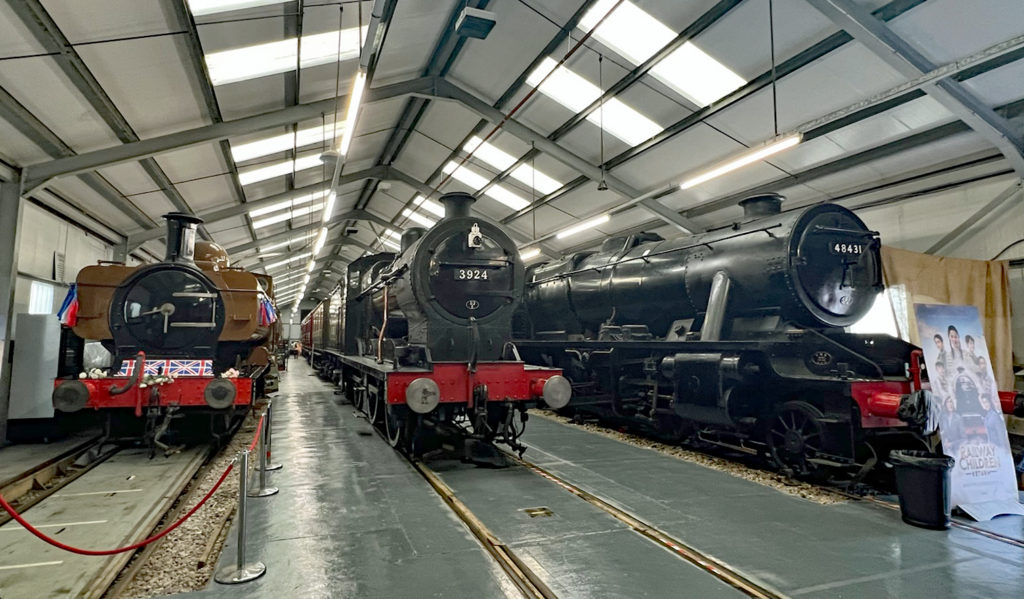The five-mile Keighley and Worth Valley Railway (KWVR) is a steeply graded single-track branch line that has a junction station at Keighley on the Leeds to Carlisle main line. From there, it climbs up the Worth Valley through Haworth, of Bronte sisters fame, to Oxenhope.
When the branch closed in 1962 a meeting was held to consider how it could be re-opened. It was here that the KWVR preservation society was formed. A company was also formed to buy the line outright, lease access to Keighley, and operate a train service. British Rail agreed to sell the line for a remarkably favourable £34,000 to be paid in 25, annual, interest-free instalments. Ownership of the line was transferred to the KWVR in 1967.
The line was re-opened on 29 June 1968 on a day when, due to a national train strike, no other trains were running. This was the second preserved standard gauge passenger railway re-opening. The first being the Bluebell line in 1960.
To celebrate its 60th anniversary, the KWVR recently held a Founders Day for those who joined the Society before its June 1968 re-opening. Having been a volunteer in the late 1960s, I was honoured to be one of around 70 early members present, though of these only a handful were at the 1962 founding meeting.

Hard graft
Chairman Matthew Stroh started the proceedings by thanking everyone for helping make the railway possible and overcoming significant challenges. This theme was taken up by former Chairman Graham Mitchell who paid particular tribute to the hard graft of early members who physically rebuilt the line after British Rail left it in a poor condition.
Graham noted that the majority at the 1962 founders meeting just wanted their railway service back and had no interest in railway preservation. However, in the six years for which line was closed, its regular users had found other ways to travel so the line re-opened as a preserved steam railway. Recognising the need to support the community, the railway offers local residents a discounted fares railcard.
He felt that much of the success of the railway was due to the way it collaborated with other groups especially the Lancashire and Yorkshire Railway Trust, Vintage Carriages Trust (VCT), and Bahamas Locomotive Society (BLS), of which the last two are based at Ingrow station.
After the speeches, the 13:35 train from Keighley had two coaches reserved for the founders, one with a real ale bar serving Worth Valley pale Ale. This train was hauled by Taff Vale Railway No 85, a 0-6-2 tank locomotive built in 1899 for service on the steep Welsh Valley lines.
On arrival at Oxenhope, there was an opportunity to visit the three-track shed which housed some of the railway’s locomotives and coaches before getting the train back to Haworth for a tour of its well-equipped locomotive sheds. In the shed was one of the railway’s most powerful locomotives. No 5850 is a 2-8-0 built in Ohio and shipped to Poland during WW2. After its withdrawal it went to a railway museum in Warsaw until USSR officialdom realised that the museum had an American locomotive. After complex negotiations, No 5850 was brought to the KWVR.
Railway children
Other founders’ tours were arranged at Ingrow and Oakworth. At Ingrow, the Museum of Rail Travel houses the carriages restored by the VCT, and BLS has its locomotive workshop and museum which explains the history of the steam locomotive.
The other tour was at the immaculately restored gas lit Oakworth station and its particularly well-preserved Midlands Railway goods shed. This is best known for being a location for the 1970 film ‘The Railway Children’ and its recently released sequel ‘The Railway Children Return’. For the original film, KWVR persuaded filmmakers to keep the name of Oakworth. Railway ticket sales doubled after the film’s release.
To accommodate this extra demand, in 1971 a loop was provided between Damens and Oakworth for which a signal box was acquired from the nearby Frizinghall station. In 1989, a turntable acquired from Garsdale was installed at Keighley.
In the railway’s early years, I often worked at Damens station, Britain’s smallest standard-gauge railway station. My duties involved operating the level crossing which was worked from a groundframe in the stationmaster’s house garden. Before signals could be cleared, this was unlocked by keys that were released when crossing gates were locked against road traffic. The station is a request stop. On the infrequent occasions when a ticket was sold, the train had to be flagged to a halt. I wondered how much coal the engine used when restarting on the 1 in 64 gradient at the station.
Today, the single coach length platform at Damens has a ticket office, waiting room, toilet, and signal cabin. In 1971, control of the crossing was transferred from the groundframe to this cabin which was rescued from Earby on the closed Skipton to Colne line. The original station building, which was completely rotten, was replaced in 1993.

opening train. A condition of its purchase from British Railways was
that it could not be painted black, hence the non-authentic crimson
livery.


Proud heritage
This year, the KWVR celebrated its 54 years of operating the line between Keighley & Oxenhope and has now operated the branch for longer than any other organisation in its 155-year history. It was one of the first preserved railways that set the scene for many other heritage railway re-openings. The Heritage Railway Association now represents 173 working railways (around 70 being standard gauge) that attract 13 million visitors each year. Between them they have 560 miles of track, 800 steam locomotives, 4,000 employees and 22,000 volunteers.
At a time when British Railways were withdrawing their last steam locomotives, it was difficult to imagine that 50 years later, there would be so many preserved railways. Over the years it has been good to see this heritage railway expansion and how this reflects Britain’s huge interest in its railways.
Report by David Shirres

